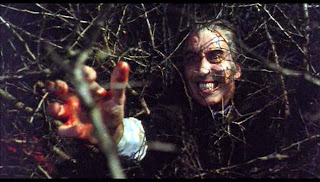Starring: Valerie Leon, Andrew Keir, James Villiers, Hugh Burden
A group of archaeologists searches for the cursed tomb of beautiful Princess Tera, an evil witch who turns out to be miraculously preserved despite the thousands of years since her death. (Concerning her appearance, perhaps the writers don't understand what the process of mummification actually entails.) Fuchs, the professor in charge of the expedition, takes her sarcophagus home to study it and becomes obsessed. Almost two decades later, his daughter Margaret comes to bear a striking resemblance to Tera and begins to have strange dreams that seem like they come from another time and place. Ancient Egypt, perhaps?
Soon Tera's dormant consciousness bleeds into Margaret's personality and she fears she is going mad. Corbeck, a member of Fuchs' archaeology group, wants Margaret to help him restore Tera to life. He convinces Margaret that Tera was wronged all those millennia ago by the priests that cut off her hand and then murdered and mummified her. Bodies begin to pile up and Fuchs realizes that he will have to choose between Princess Tera and his own daughter.
An average, if silly entry into the Hammer horror canon, it should come as no surprise that they had to explore their own version of The Mummy, but the script by Christopher Wicking is a bit of a mess. Based on Bram Stoker's novel The Jewel of Seven Stars, Blood from the Mummy's Tomb is the first film to actually adapt this novel, though it was a direct influence on several earlier mummy-themed horror films. And to its credit, it’s undoubtedly the best film in Hammer’s four-film Mummy series, leaving The Curse of the Mummy’s Tomb and The Mummy’s Shroud in the dust (a little desert humor for you) and nearly going toe-to-toe with The Mummy.
There are plenty of worthwhile elements to this film, namely the lovely cinematography and trademark Hammer atmosphere. If you are a fan of mummy films or Hammer productions in general, this is a worthy entry in the genre and it manages to be a lot more fun than any number of other mummy-themed films that spring to mind. Also, if you are a fan of boobs this is the movie for you. Valerie Leon's rack is so prominent as to be completely distracting. There were actually moments I was unable to focus on plot or dialogue and had to rewind.

You aren't even reading this review anymore, are you?
This was a rare starring role for the busty Leon, though she also appeared in The Italian Job, The Spy Who Loved Me, Revenge of the Pink Panther, Never Say Never Again, and several Carry On films, though it’s really a shame Hammer never used her again.
Blood from the Mummy's Tomb was intended to be a companion piece for the superior late-era Hammer film Dr. Jekyll and Sister Hyde, which in turn was riding the coattails of the very creepy Hands of the Ripper. Blood from the Mummy’s Tomb had a troubled production history, namely the re-casting of Peter Cushing who originally signed on as Fuchs, but left due to a family illness. It is undeniable that the film would have benefited from his presence — he actually could have helped this to be even better than Hammer’s original The Mummy. There was also the sudden death of director Seth Holt, who had a heart attack during filming. Mummy's curse indeed...
There's a nice Hammer Collection DVD from Anchor Bay that is out of print, but readily available online. It includes some trailers and interviews, but what more can you expect from a latter day Hammer effort? Out of all the Hammer Mummy films, I think I would have to recommend this one the most highly. While the first does include Christopher Lee (as the titular mummy) and Peter Cushing as the protagonist, Blood from the Mummy’s Tomb is colorful, fun, and very campy, and no doubt was at least a little inspired by Bava’s Black Sunday.












